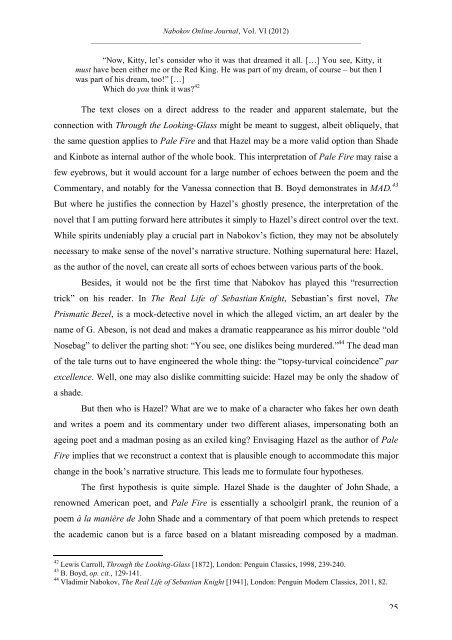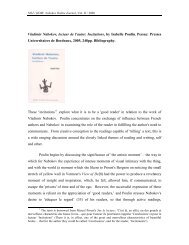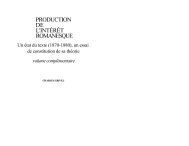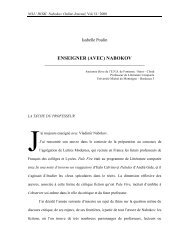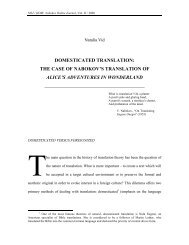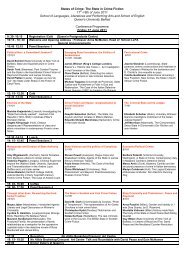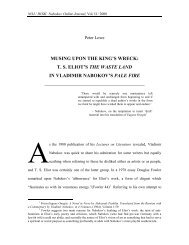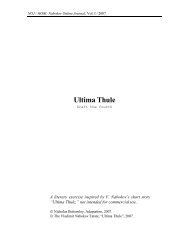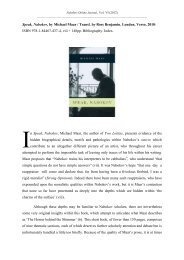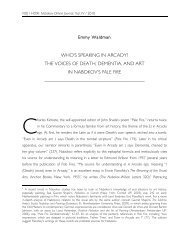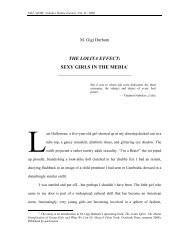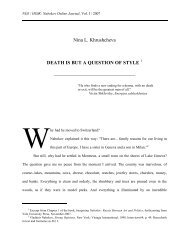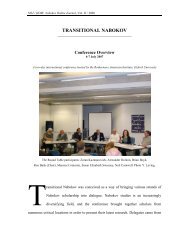through the looking-glass – pale fire as anamorphosis
through the looking-glass – pale fire as anamorphosis
through the looking-glass – pale fire as anamorphosis
You also want an ePaper? Increase the reach of your titles
YUMPU automatically turns print PDFs into web optimized ePapers that Google loves.
Nabokov Online Journal, Vol. VI (2012)<br />
_______________________________________________________________________<br />
“Now, Kitty, let’s consider who it w<strong>as</strong> that dreamed it all. […] You see, Kitty, it<br />
must have been ei<strong>the</strong>r me or <strong>the</strong> Red King. He w<strong>as</strong> part of my dream, of course <strong>–</strong> but <strong>the</strong>n I<br />
w<strong>as</strong> part of his dream, too!” […]<br />
Which do you think it w<strong>as</strong>? 42<br />
The text closes on a direct address to <strong>the</strong> reader and apparent stalemate, but <strong>the</strong><br />
connection with Through <strong>the</strong> Looking-Gl<strong>as</strong>s might be meant to suggest, albeit obliquely, that<br />
<strong>the</strong> same question applies to Pale Fire and that Hazel may be a more valid option than Shade<br />
and Kinbote <strong>as</strong> internal author of <strong>the</strong> whole book. This interpretation of Pale Fire may raise a<br />
few eyebrows, but it would account for a large number of echoes between <strong>the</strong> poem and <strong>the</strong><br />
Commentary, and notably for <strong>the</strong> Vanessa connection that B. Boyd demonstrates in MAD. 43<br />
But where he justifies <strong>the</strong> connection by Hazel’s ghostly presence, <strong>the</strong> interpretation of <strong>the</strong><br />
novel that I am putting forward here attributes it simply to Hazel’s direct control over <strong>the</strong> text.<br />
While spirits undeniably play a crucial part in Nabokov’s fiction, <strong>the</strong>y may not be absolutely<br />
necessary to make sense of <strong>the</strong> novel’s narrative structure. Nothing supernatural here: Hazel,<br />
<strong>as</strong> <strong>the</strong> author of <strong>the</strong> novel, can create all sorts of echoes between various parts of <strong>the</strong> book.<br />
Besides, it would not be <strong>the</strong> first time that Nabokov h<strong>as</strong> played this “resurrection<br />
trick” on his reader. In The Real Life of Seb<strong>as</strong>tian Knight, Seb<strong>as</strong>tian’s first novel, The<br />
Prismatic Bezel, is a mock-detective novel in which <strong>the</strong> alleged victim, an art dealer by <strong>the</strong><br />
name of G. Abeson, is not dead and makes a dramatic reappearance <strong>as</strong> his mirror double “old<br />
Nosebag” to deliver <strong>the</strong> parting shot: “You see, one dislikes being murdered.” 44 The dead man<br />
of <strong>the</strong> tale turns out to have engineered <strong>the</strong> whole thing: <strong>the</strong> “topsy-turvical coincidence” par<br />
excellence. Well, one may also dislike committing suicide: Hazel may be only <strong>the</strong> shadow of<br />
a shade.<br />
But <strong>the</strong>n who is Hazel? What are we to make of a character who fakes her own death<br />
and writes a poem and its commentary under two different ali<strong>as</strong>es, impersonating both an<br />
ageing poet and a madman posing <strong>as</strong> an exiled king? Envisaging Hazel <strong>as</strong> <strong>the</strong> author of Pale<br />
Fire implies that we reconstruct a context that is plausible enough to accommodate this major<br />
change in <strong>the</strong> book’s narrative structure. This leads me to formulate four hypo<strong>the</strong>ses.<br />
The first hypo<strong>the</strong>sis is quite simple. Hazel Shade is <strong>the</strong> daughter of John Shade, a<br />
renowned American poet, and Pale Fire is essentially a schoolgirl prank, <strong>the</strong> reunion of a<br />
poem à la manière de John Shade and a commentary of that poem which pretends to respect<br />
<strong>the</strong> academic canon but is a farce b<strong>as</strong>ed on a blatant misreading composed by a madman.<br />
42<br />
Lewis Carroll, Through <strong>the</strong> Looking-Gl<strong>as</strong>s [1872], London: Penguin Cl<strong>as</strong>sics, 1998, 239-240.<br />
43<br />
B. Boyd, op. cit., 129-141.<br />
44<br />
Vladimir Nabokov, The Real Life of Seb<strong>as</strong>tian Knight [1941], London: Penguin Modern Cl<strong>as</strong>sics, 2011, 82.<br />
25


